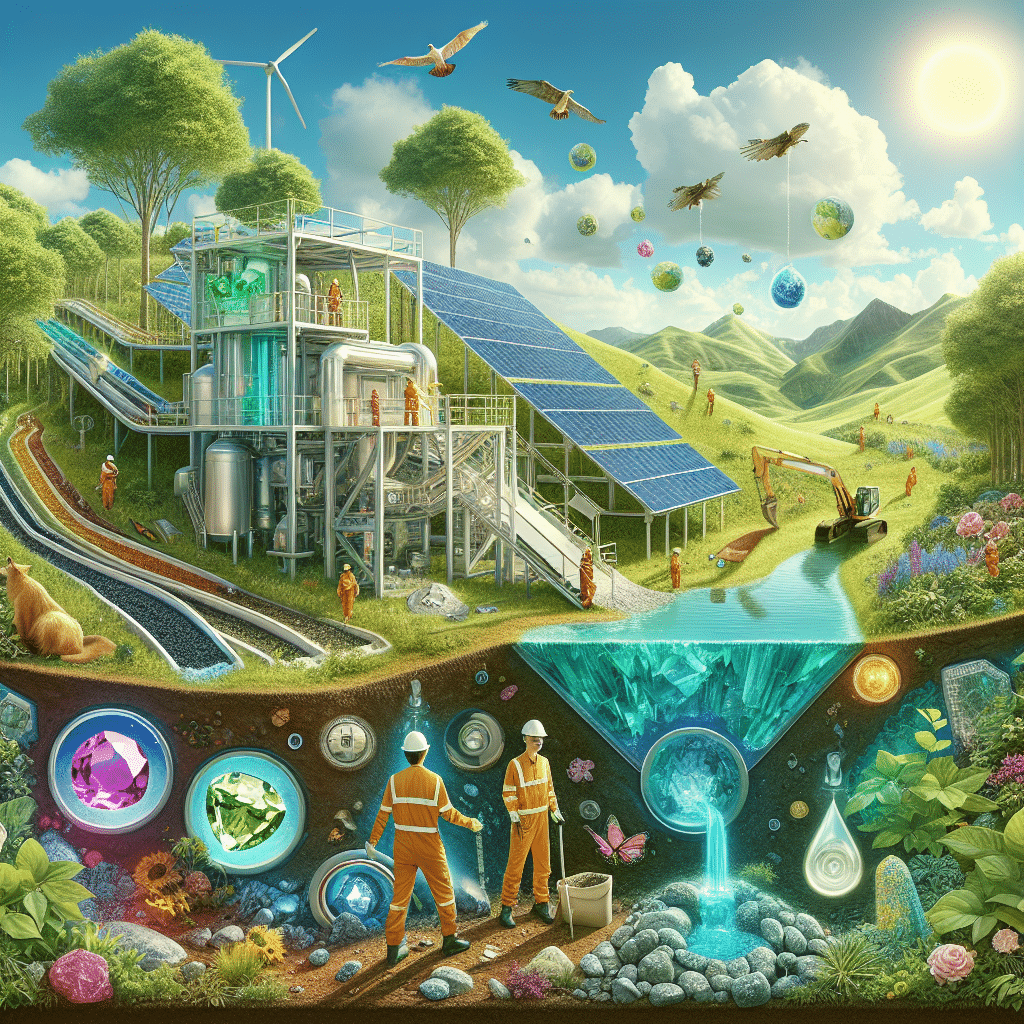: Home » Blog » Mayhem Canyon Mine News » Eco-Friendly Mining: Revolutionizing Gemstone Extraction

: Home » Blog » Mayhem Canyon Mine News » Eco-Friendly Mining: Revolutionizing Gemstone Extraction
Sustainable Practices in Gemstone Extraction: A Step Towards Eco-Friendly Mining
When we think of mining, we often picture large machinery tearing through the earth, leaving behind a trail of destruction. However, the mining industry is evolving, and a new era of Eco-Friendly Mining is emerging. In particular, the gemstone extraction sector is taking significant steps towards sustainability, recognizing the importance of preserving the environment while meeting the demand for these precious stones.
One of the key aspects of Eco-Friendly Mining is the use of sustainable practices throughout the entire extraction process. This includes everything from exploration and excavation to processing and transportation. By implementing these practices, mining companies can minimize their environmental impact and contribute to a greener future.
Exploration is the first step in gemstone extraction, and it is crucial to ensure that it is done in an environmentally responsible manner. Traditional exploration methods often involve extensive drilling and excavation, which can lead to habitat destruction and soil erosion. However, Eco-Friendly Mining companies are now utilizing advanced technologies such as remote sensing and satellite imagery to identify potential gemstone deposits without disturbing the surrounding ecosystems.
Once a gemstone deposit is identified, the next step is excavation. In the past, this process involved large-scale open-pit mining, which caused significant damage to the land and displaced local communities. However, Eco-Friendly Mining companies are now embracing more sustainable methods such as underground mining and small-scale artisanal mining. These methods minimize the environmental impact and prioritize the well-being of local communities.
Processing gemstones is another area where sustainable practices are making a difference. Traditional processing methods often involve the use of harmful chemicals and excessive water consumption. However, Eco-Friendly Mining companies are adopting cleaner and more efficient processing techniques. For example, they are using water recycling systems to minimize water usage and implementing non-toxic alternatives to harmful chemicals.
Transportation is another aspect of gemstone extraction that is being revolutionized by eco-friendly practices. Traditional transportation methods often involve long-haul trucking, which contributes to air pollution and greenhouse gas emissions. However, Eco-Friendly Mining companies are now exploring alternative transportation options such as rail and sea freight, which have a lower carbon footprint. Additionally, they are also investing in electric vehicles and hybrid trucks to further reduce emissions.
In addition to these sustainable practices, Eco-Friendly Mining companies are also prioritizing the well-being of local communities and promoting fair trade practices. They are working closely with local stakeholders to ensure that the benefits of gemstone extraction are shared equitably. This includes providing fair wages and safe working conditions for miners, as well as supporting community development projects.
The shift towards Eco-Friendly Mining in the gemstone extraction sector is a positive step towards a more sustainable future. By implementing sustainable practices throughout the entire extraction process, mining companies can minimize their environmental impact and contribute to the preservation of our planet. Furthermore, by prioritizing the well-being of local communities, they can ensure that the benefits of gemstone extraction are shared equitably. As consumers, we can also play a role by supporting Eco-Friendly Mining practices and choosing ethically sourced gemstones. Together, we can pave the way for a greener and more responsible mining industry.
Mining is an essential industry that has been around for centuries, providing us with valuable resources that we use in our everyday lives. However, traditional mining practices have often had a negative impact on the environment, causing deforestation, soil erosion, and water pollution. In recent years, there has been a growing movement towards Eco-Friendly Mining, which aims to minimize these harmful effects and promote sustainable practices. One crucial aspect of Eco-Friendly Mining is the use of renewable energy sources, such as solar and wind power, to power mining operations.
Renewable energy has gained significant attention in recent years as a viable alternative to fossil fuels. Solar and wind power, in particular, have become increasingly popular due to their abundance and low environmental impact. These energy sources harness the power of the sun and wind, respectively, and convert it into electricity that can be used to power various mining equipment and machinery.
One of the main advantages of using renewable energy in gemstone mining is its ability to reduce greenhouse gas emissions. Traditional mining operations heavily rely on diesel-powered machinery, which releases large amounts of carbon dioxide into the atmosphere. By switching to renewable energy sources, mining companies can significantly reduce their carbon footprint and contribute to the fight against climate change.
Moreover, renewable energy can help mining operations become more self-sufficient and less reliant on external energy sources. Remote mining sites often face challenges in accessing electricity from the grid, leading to the use of expensive and polluting diesel generators. By installing solar panels or wind turbines on-site, mining companies can generate their own electricity, reducing costs and minimizing their environmental impact.
Another benefit of renewable energy in gemstone mining is its potential for job creation and economic growth. The transition to renewable energy requires the installation and maintenance of solar panels, wind turbines, and other related infrastructure. This creates new job opportunities in the renewable energy sector, helping to stimulate local economies and promote sustainable development.
In addition to reducing emissions and promoting self-sufficiency, renewable energy can also improve the overall efficiency of mining operations. Solar and wind power systems can be integrated with advanced technologies, such as energy storage systems and smart grids, to optimize energy usage and minimize waste. This can lead to significant cost savings for mining companies, as well as a more sustainable and efficient use of resources.
However, it is important to acknowledge that the adoption of renewable energy in gemstone mining is not without its challenges. The initial investment required for installing solar panels or wind turbines can be substantial, making it difficult for small-scale mining operations to afford the transition. Additionally, the intermittent nature of solar and wind power can pose challenges in ensuring a consistent energy supply for mining operations.
Despite these challenges, the potential benefits of renewable energy in gemstone mining cannot be ignored. As technology continues to advance and costs decrease, the adoption of renewable energy is becoming increasingly feasible for mining companies of all sizes. By embracing eco-friendly practices and harnessing the power of renewable energy, the mining industry can pave the way for a more sustainable and responsible future.

Mining is an essential industry that provides us with valuable resources, but it often comes at a significant cost to the environment. The extraction of gemstones, in particular, has been associated with various environmental issues, such as water pollution and habitat destruction. However, in recent years, there have been significant advancements in water management techniques that are revolutionizing the way gemstones are extracted. These innovations are not only reducing the environmental impact of mining but also ensuring a sustainable future for the industry.
One of the most promising innovations in water management for environmentally conscious gemstone extraction is the use of closed-loop systems. Traditionally, mining operations would use large amounts of water to wash away the dirt and debris to uncover gemstones. This process often resulted in the contamination of nearby water sources with sediment and harmful chemicals. Closed-loop systems, on the other hand, recycle and reuse water, minimizing the need for fresh water intake and reducing the amount of wastewater generated. This not only conserves water resources but also prevents the pollution of surrounding ecosystems.
Another innovative approach to water management in gemstone extraction is the use of advanced filtration systems. These systems are designed to remove impurities and contaminants from the water used in mining operations. By effectively treating the wastewater, these filtration systems ensure that the water can be safely discharged back into the environment or reused in the mining process. This not only protects local water sources but also reduces the need for freshwater intake, further conserving this precious resource.
In addition to closed-loop systems and advanced filtration, the mining industry is also exploring the use of sustainable water sources. Instead of relying solely on freshwater, mining operations are increasingly turning to alternative sources such as rainwater harvesting and wastewater treatment plants. Rainwater harvesting involves collecting and storing rainwater for use in mining operations, reducing the reliance on freshwater sources. Wastewater treatment plants, on the other hand, treat and purify wastewater from nearby communities, making it suitable for use in mining activities. By utilizing these sustainable water sources, the mining industry can significantly reduce its impact on freshwater ecosystems.
Furthermore, technology is playing a crucial role in improving water management practices in gemstone extraction. Remote monitoring systems, for example, allow mining companies to track water usage and quality in real-time. This enables them to identify and address any issues promptly, minimizing the potential for environmental harm. Additionally, advanced data analytics can help optimize water usage, ensuring that only the necessary amount of water is used in the mining process. By harnessing the power of technology, the mining industry can achieve greater efficiency and sustainability in water management.
In conclusion, innovations in water management are transforming gemstone extraction into an eco-friendly and sustainable industry. Closed-loop systems, advanced filtration, the use of sustainable water sources, and technological advancements are all contributing to a more environmentally conscious approach to mining. By reducing water consumption, preventing pollution, and conserving freshwater resources, these innovations are paving the way for a greener future. As consumers become increasingly aware of the environmental impact of their purchases, Eco-Friendly Mining practices will become even more crucial. With continued research and development, the mining industry can ensure that gemstone extraction is not only profitable but also sustainable and environmentally responsible.
Eco-Friendly Mining: The Future of Gemstone Extraction
When we think of mining, we often picture large machinery tearing through the earth, leaving behind a trail of destruction. However, the mining industry is evolving, and a new approach called Eco-Friendly Mining is gaining traction. This innovative technique aims to reduce the carbon footprint associated with gemstone extraction, making it a more sustainable and environmentally friendly process.
One of the key ways Eco-Friendly Mining reduces carbon emissions is through the use of renewable energy sources. Traditional mining operations rely heavily on fossil fuels to power their machinery, contributing to greenhouse gas emissions and climate change. In contrast, Eco-Friendly Mining harnesses the power of the sun, wind, and water to generate clean energy. By utilizing solar panels, wind turbines, and hydroelectric power, mining companies can significantly reduce their carbon footprint.
Another important aspect of Eco-Friendly Mining is the responsible use of water resources. Traditional mining methods often require large amounts of water for processing and dust suppression. This can put a strain on local water supplies and lead to pollution of nearby rivers and streams. Eco-Friendly Mining techniques prioritize water conservation and recycling. Advanced filtration systems are used to treat and reuse water, minimizing the need for fresh water intake and reducing the impact on the environment.
Furthermore, Eco-Friendly Mining promotes the use of sustainable materials and practices. This includes using biodegradable lubricants and chemicals, as well as implementing reclamation plans to restore mined areas to their natural state. By prioritizing sustainability, mining companies can minimize their ecological footprint and ensure the long-term health of the surrounding ecosystems.
In addition to reducing carbon emissions and promoting sustainability, Eco-Friendly Mining also prioritizes the safety and well-being of workers. Traditional mining operations can be hazardous, with high rates of accidents and health issues due to exposure to toxic substances. Eco-Friendly Mining techniques prioritize worker safety by implementing strict safety protocols and providing protective equipment. This not only protects the workers but also improves the overall reputation of the mining industry.
The adoption of Eco-Friendly Mining techniques is not without its challenges. The initial investment required to transition to renewable energy sources and implement sustainable practices can be significant. However, the long-term benefits far outweigh the costs. By reducing carbon emissions and minimizing environmental impact, mining companies can improve their public image and attract environmentally conscious consumers. Additionally, the use of renewable energy sources can lead to cost savings in the long run, as the price of fossil fuels continues to rise.
The future of gemstone extraction lies in Eco-Friendly Mining. As consumers become more aware of the environmental impact of their purchases, the demand for sustainably sourced gemstones is on the rise. By embracing renewable energy, conserving water resources, and prioritizing sustainability, mining companies can meet this demand while minimizing their carbon footprint. Eco-Friendly Mining is not just a trend; it is the way forward for the mining industry.
Mining has long been associated with negative environmental impacts, from deforestation to water pollution. However, in recent years, there has been a growing movement towards Eco-Friendly Mining practices, particularly in the extraction of gemstones. These practices aim to minimize the ecological footprint of mining operations and promote biodiversity conservation.
One of the key ways in which Eco-Friendly Mining promotes biodiversity conservation is through the use of sustainable mining techniques. Traditional mining methods often involve the use of heavy machinery and chemicals, which can have devastating effects on local ecosystems. In contrast, Eco-Friendly Mining practices prioritize the use of low-impact methods that minimize disturbance to the surrounding environment.
For example, instead of using dynamite to blast through rock formations, eco-friendly miners may opt for manual or small-scale mechanized techniques. This not only reduces noise and air pollution but also minimizes the risk of habitat destruction and soil erosion. By taking a more careful and considered approach to mining, these practices help to protect the delicate balance of local ecosystems.
Another important aspect of Eco-Friendly Mining is the responsible management of waste materials. In traditional mining operations, large amounts of waste rock and tailings are often left behind, which can contaminate nearby water sources and disrupt aquatic ecosystems. Eco-Friendly Mining practices, on the other hand, prioritize the proper disposal and treatment of waste materials.
This can involve techniques such as backfilling, where waste rock is used to fill in excavated areas, or the construction of containment ponds to capture and treat contaminated water. By effectively managing waste materials, Eco-Friendly Mining practices help to prevent the spread of pollutants and protect the health of both terrestrial and aquatic species.
In addition to sustainable mining techniques and waste management, Eco-Friendly Mining also involves the restoration and rehabilitation of mined-out areas. After a mining operation is completed, eco-friendly miners work to restore the land to its original state or, in some cases, even improve upon it. This can involve activities such as reforestation, soil stabilization, and the reintroduction of native plant and animal species.
By restoring mined-out areas, Eco-Friendly Mining practices help to create new habitats and promote the recovery of biodiversity. This is particularly important in regions with high levels of endemic species, as mining activities can often result in the loss of unique and irreplaceable ecosystems. Through their commitment to restoration, eco-friendly miners are working to ensure that the impacts of mining are minimized and that biodiversity is conserved for future generations.
In conclusion, Eco-Friendly Mining practices are playing a crucial role in promoting biodiversity conservation in the extraction of gemstones. By prioritizing sustainable mining techniques, responsible waste management, and the restoration of mined-out areas, these practices are helping to minimize the ecological footprint of mining operations and protect the delicate balance of local ecosystems. As the demand for gemstones continues to grow, it is essential that the industry embraces Eco-Friendly Mining as the future of gemstone extraction. Only through these practices can we ensure that the beauty of gemstones is not achieved at the expense of our planet’s biodiversity.

